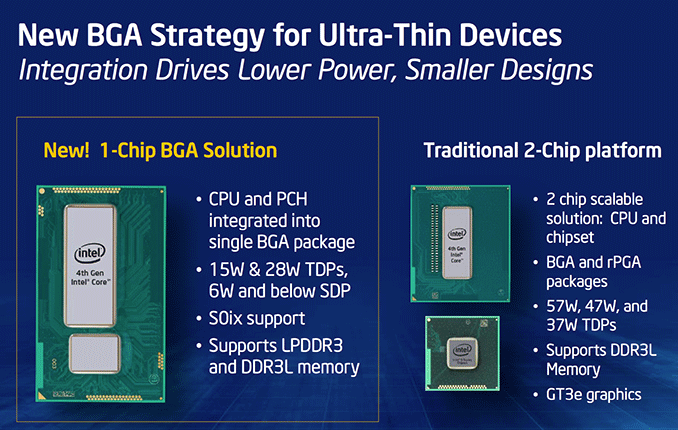The Haswell Ultrabook Review: Core i7-4500U Tested
by Anand Lal Shimpi on June 9, 2013 9:00 AM ESTOn-Package PCH, The First Single Chip Haswell
In 2010, with Clarkdale and Arrandale, Intel went from a 3-chip platform solution (CPU, IOH/MCH, ICH) down to a 2-chip platform (CPU + PCH). With Haswell, we see the first instantiation of a single-chip Core platform.
With the 8-series chipset, Intel moved from a 65nm process on the 7-series chipset to 32nm, skipping 45nm entirely. An older, less mobile-focused Intel would try to keep its chipsets on the oldest, economically sensible node possible, but these days things are different. The move to 32nm cuts TDP down considerably. Intel hasn’t publicly documented the power consumption any of its ultra mobile chipsets, but if we look at QM77 to QM87 we see a 34% decrease in TDP.
In Haswell desktop and standard voltage mobile parts, the 8-series chipset remains a an off-chip solution in a discrete package. With Haswell ULT and ULX (U and Y series SKUs), the 8-series PCH (Platform Controller Hub) moves on-package. Since it’s on-package, the TDP of the PCH is included in the overall TDP of the processor.
Bringing the PCH on-package not only saves space on the motherboard, but it also reduces the power needed to communicate with the chip. Signals no longer have to travel off die, through the package, via traces on the motherboard to the PCH. Instead you get much lower power on-package communication.
Intel also changed the interface between the CPU and PCH to a new on-package interface instead of DMI. Presumably Intel’s OPI is designed for much lower power operation.
Although PCIe support remains on the PCH (6 PCIe 2.0 lanes), there’s no external PCIe interface from the CPU itself. Any hopes for pairing a meaningfully high performance discrete GPU with Haswell ULT are dead. We didn’t see a ton of Ivy Bridge Ultrabooks with discrete GPUs, but the option simply won’t exist this time around. All of the sudden the creation of Intel’s 28W Haswell ULT with GT3 graphics makes a lot more sense. Haswell ULT lacks native VGA support. Update: NVIDIA tells me that it fully supports running a dGPU off of a x4 connection to the PCH. It's not the ideal solution, but discrete GPUs will still technically be possible with Haswell ULT.
Intel adds SDIO support. USB 3 and 6Gbps SATA are both there as well (although with fewer max ports supported compared to the desktop PCH, up to 4 and 3 respectively). There’s also a lot more sharing of bandwidth between individual PCIe lanes and USB/SATA. These limits shouldn’t be an issue given the port/drive configuration of most Ultrabooks.











87 Comments
View All Comments
warezme - Monday, June 10, 2013 - link
"the processor graphics story by finally delivering discrete GPU class gaming performance". I hate this summation being thrown around, as I'm sure it will get re quoted somewhere as gospel. It is definitely NOT discrete GPU class gaming performance in any shape or form. There should be a limit to what is considered discrete GPU performance, like maybe 30-60FPS at, at least 1600x900 resolution and game settings across the board for all games set to Medium. That is not crazy or unreasonable for a true discrete GPU you would actually go out and buy. It shouldn't be unreasonable than to expect that in a built in GPU that is sold as "discrete GPU" quality.gnx - Monday, June 10, 2013 - link
Kudos! You have to love AnandTech for providing such detailed analysis, so soon after Haswell was made public!But it does seem that Haswell for Ultrabooks isn't so revolutionary as Intel seemed to imply. Not that we have much of a choice, since ARM isn't an option, and AMD doesn't provide much of an alternative, but I was personally hoping for more from Haswell.
Maybe it's change the equation for Windows Tablets? look forward to more from AnandTech!
Kiijibari - Monday, June 10, 2013 - link
Can you please add Wh numbers in the Battery Life Test graph (http://images.anandtech.com/graphs/graph7047/55504... or normalize them at least like in the previous tables? Seems to me that you compare 2 different batteries there. Haswell is great sure, but not THAT great ;-)Yes it is explained in the text below, but a picture not matching the numbers in the text is useless and misleading. A picture should be worth more than 1000 words and not demand reading 1000 words of explanation ;-)
broccauley - Tuesday, June 11, 2013 - link
Does anyone know what the status of "activity alignment" for power optimisation is on the Linux kernel and how it compares with Windows 8? I assume such techniques were added when the changes from the Android branch were merged?Henry 3 Dogg - Tuesday, June 11, 2013 - link
"And today, we had to track down a pre-production Haswell Ultrabook in Taiwan to even be able to bring you this review of Haswell ULT."And today, a day later, you can pick up a production Haswell ULT based MacBook Air in your local Apple store.
lhurt - Tuesday, June 11, 2013 - link
So are Platform Activity Manager (Windows) and Timer Coalescing (OSx) two different OS implementations of the same idea, to take advantage of Intel's Power Optimizer and are Haswell cpus required to get the benefit?fteoath64 - Saturday, June 15, 2013 - link
"Any hopes for pairing a meaningfully high performance discrete GPU with Haswell ULT are dead."This is Intel's method of CLOSING other discrete GPU solution on their cpus towards the future. This is a predatory move and premeditated !. Just stop buying their chips as this is forcing users into a proprietary path using their inferior gpu technology. It is a selfish and disgusting move. Now ARM is going to cream them on the desktop side as well soon and server side in time.